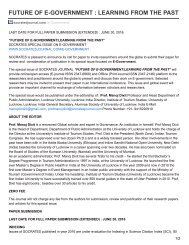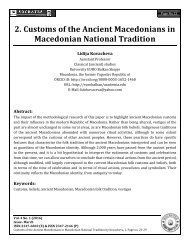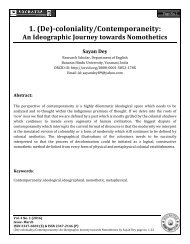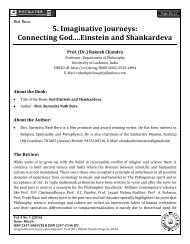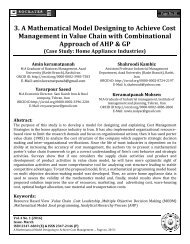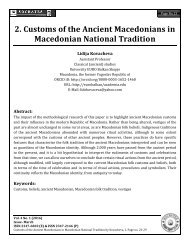Minority Education | A study of Indian Muslims.
Noor, A. (2016). Minority Education | A study of Indian Muslims. S O C R A T E S, 4(1), 52-60. Retrieved from http://socratesjournal.com/index.php/socrates/article/view/198
Noor, A. (2016). Minority Education | A study of Indian Muslims. S O C R A T E S, 4(1), 52-60. Retrieved from http://socratesjournal.com/index.php/socrates/article/view/198
You also want an ePaper? Increase the reach of your titles
YUMPU automatically turns print PDFs into web optimized ePapers that Google loves.
Page No.52<br />
4. <strong>Minority</strong> <strong>Education</strong> | A <strong>study</strong> <strong>of</strong> <strong>Indian</strong> <strong>Muslims</strong><br />
Ansari Fatima Noor<br />
Research Scholar, Dept. <strong>of</strong> Public Administration,<br />
University <strong>of</strong> Lucknow India<br />
ORCID iD: http://orcid.org/0000-0002-7389-5656<br />
E-Mail: noorfatima012@gmail.com<br />
Abstract<br />
It is a universally accepted fact that education is the most potent and effective tool to achieve<br />
empowerment <strong>of</strong> any section <strong>of</strong> society. <strong>Muslims</strong> in India lag behind in education is a sad aspect <strong>of</strong><br />
their life. It is a matter <strong>of</strong> common beliefs that unless Muslim educational backwardness is addressed,<br />
the empowerment <strong>of</strong> <strong>Indian</strong> <strong>Muslims</strong> would remain elusive. The <strong>Muslims</strong> in India would remain<br />
politically marginalized and economically poor unless they overcome their educational<br />
backwardness. <strong>Education</strong> holds the key to the empowerment <strong>of</strong> <strong>Indian</strong> <strong>Muslims</strong>. <strong>Education</strong> is one <strong>of</strong><br />
the most powerful factors for the political, social, economic and spiritual development <strong>of</strong> individuals<br />
and communities. It is a well known fact that India cannot march on the path <strong>of</strong> development and<br />
claim to be world leader if majority <strong>of</strong> its minority community remains educationally backward. High<br />
dropout rates among Muslim students are worrisome. As with many <strong>Indian</strong>s, the main reason for<br />
educational backwardness <strong>of</strong> <strong>Muslims</strong> is abject poverty due to which children are forced to drop out<br />
after the first few classes.<br />
Keywords<br />
Empowerment; Development; Backwardness; Discrimination<br />
Vol. 4 No. 1 (2016)<br />
Issue- March<br />
ISSN 2347-6869 (E) & ISSN 2347-2146 (P)<br />
<strong>Minority</strong> <strong>Education</strong> | A <strong>study</strong> <strong>of</strong> <strong>Indian</strong> <strong>Muslims</strong> by Ansari Fatima Noor Page No. 52-60
Page No.53<br />
<strong>Minority</strong> <strong>Education</strong> | A <strong>study</strong> <strong>of</strong> <strong>Indian</strong> <strong>Muslims</strong><br />
The <strong>Muslims</strong> <strong>of</strong> India are the major religious minority within India and one <strong>of</strong> the largest<br />
Muslim communities in the world. However, they are a relatively small group, comprising only 13%<br />
to 14% <strong>of</strong> the population in an overwhelmingly Hindu society.<br />
It is a universally accepted fact that education is the most potent and effective tool to achieve<br />
empowerment <strong>of</strong> any section <strong>of</strong> society. Although it is true that economic well-being also makes a<br />
significant contribution in this regard, yet the nature <strong>of</strong> positive change brought about by education<br />
ensures a position <strong>of</strong> dignity for the individual and the community which instils a sense <strong>of</strong> confidence<br />
and self-worth. Elevation <strong>of</strong> social and economic status is usually natural outcomes <strong>of</strong> good<br />
education.<br />
At the time <strong>of</strong> adopting the Constitution the <strong>Indian</strong> state had committed itself to provide<br />
elementary education under Article 45 <strong>of</strong> the Directive Principles <strong>of</strong> State Policy. Article 45<br />
state that "The State shall endeavour to provide within a period <strong>of</strong> ten years from the commencement<br />
<strong>of</strong> this Constitution, for free and compulsory education for all children until they complete the age <strong>of</strong><br />
fourteen years," In 1993, in a landmark judgement, the Supreme Court ruled that the right to<br />
education is a fundamental right flowing from the Right to Life in Article 21 <strong>of</strong> the Constitution.<br />
Subsequently in 2002 education as a fundamental right was endorsed through the 86th amendment<br />
to the Constitution. Article 21-A states that "The State shall provide free and compulsory education to<br />
all children <strong>of</strong> the age six to fourteen years in such a way as the state may, by law, determine.” The 86th<br />
Amendment also modified Article 45 which now reads as "The state shall endeavour to provide early<br />
childhood care and education for all children until they complete the age <strong>of</strong> 6 years."<br />
However, despite the commitment the number <strong>of</strong> children in this age group who have<br />
remained out <strong>of</strong> school is alarmingly large.<br />
<strong>Muslims</strong> in India lag behind in education is a sad commentary on a community whose holy<br />
book Quran is derived from the word meaning reading. The very first verse <strong>of</strong> the Quran 'Iqra/bi-ismi<br />
rabbika allathee khalaqa....." is an exertion to read. Our Holy Prophet (S.A.W.), said, Seek knowledge<br />
from the cradle to the grave. And: Seek, knowledge even if it is to be found in a place as distant as China.<br />
It is a matter <strong>of</strong> utter surprise and shock that despite great emphasis <strong>of</strong> Islam on seeking Ilm<br />
(knowledge) why its followers in secular India lag behind. The various commissions appointed by the<br />
Government <strong>of</strong> India and independent researchers have repeatedly confirmed the poor plight <strong>of</strong><br />
Muslim education in India. The situation has become so depressing that if urgent remedial measures<br />
are not undertaken, the things would slip out <strong>of</strong> hand. It is a matter <strong>of</strong> common beliefs that unless<br />
Muslim educational backwardness is addressed, the empowerment <strong>of</strong> <strong>Indian</strong> <strong>Muslims</strong> would remain<br />
elusive. The <strong>Muslims</strong> in India would remain politically marginalized and economically poor unless<br />
they overcome their educational backwardness. <strong>Education</strong> holds the key to the empowerment <strong>of</strong><br />
Vol. 4 No. 1 (2016)<br />
Issue- March<br />
ISSN 2347-6869 (E) & ISSN 2347-2146 (P)<br />
<strong>Minority</strong> <strong>Education</strong> | A <strong>study</strong> <strong>of</strong> <strong>Indian</strong> <strong>Muslims</strong> by Ansari Fatima Noor Page No. 52-60
Page No.54<br />
<strong>Indian</strong> <strong>Muslims</strong>. <strong>Education</strong> is one <strong>of</strong> the most powerful factors for the political, social, economic or<br />
spiritual development <strong>of</strong> individuals and communities. It helps individuals to acquire the confidence<br />
and capability to match the levels <strong>of</strong> those who are in the mainstream in society. The founder <strong>of</strong> this<br />
great seat <strong>of</strong> learning Sir Syed had realised that education was the only remedy for the ills afflicting<br />
the <strong>Indian</strong> <strong>Muslims</strong>. He regarded modern education as the only means by which the <strong>Muslims</strong> could be<br />
extricated from the quagmire <strong>of</strong> stagnation and set on the path <strong>of</strong> progress.<br />
It is a well known fact that India cannot march on the path <strong>of</strong> development and claim to be<br />
world leader if majority <strong>of</strong> its minority community remain educationally backward. If this trend is<br />
not arrested it will have the adverse effect pulling down the general growth <strong>of</strong> the country. It is well<br />
stated that if the house <strong>of</strong> my neighbour is burning, my house cannot remain protected for a long<br />
period. One day the flame <strong>of</strong> my neighbour will engulf my house as well. This is to simply to lay<br />
emphasis on the fact that the task <strong>of</strong> empowerment <strong>of</strong> <strong>Indian</strong> <strong>Muslims</strong> should be our national concern<br />
and priority. This is also not to underplay the fact that it is the Muslim community that has to<br />
ultimately alarm the nation about their plight and take initiative so that others can join them in their<br />
task <strong>of</strong> saving the community from complete debacle. There cannot be two opinions on the fact that<br />
the government must come out with a comprehensive plan to improve the educational condition <strong>of</strong><br />
<strong>Muslims</strong>. But at the same time it is also equally necessary for <strong>Muslims</strong> to shave their own<br />
responsibility in coming out <strong>of</strong> the quagmire and empower themselves educationally. It is only<br />
through the joint efforts <strong>of</strong> State and Muslim community that we can achieve the goal <strong>of</strong> taking the<br />
community out from the darkness <strong>of</strong> the educational backwardness.<br />
As mentioned earlier, education is an area <strong>of</strong> grave concern for the Muslim Community. The<br />
popular perception that religious conservatism among <strong>Muslims</strong> is a major factor for not accessing<br />
education is incorrect. The recognition <strong>of</strong> their educational backwardness is quite acute amongst a<br />
large section <strong>of</strong> <strong>Indian</strong> <strong>Muslims</strong> and they wish to rectify it urgently. There is a significant internal<br />
debate about how this should be done. Private minority institutions and Madarsas are seen as the<br />
only option available to the community for improving the educational status <strong>of</strong> <strong>Muslims</strong> Community.<br />
However, others find these to be questionable alternative pursued by the state neglecting its own<br />
responsibility. Relying predominantly on Madarsa and denominational institutions for improving the<br />
educational states <strong>of</strong> <strong>Muslims</strong> was also seen by some as violating the spirit <strong>of</strong> the Constitution.<br />
High dropout rates among Muslim students are worrisome. As with many <strong>Indian</strong>s, the main<br />
reason for educational backwardness <strong>of</strong> <strong>Muslims</strong> is abject poverty due to which children are forced<br />
to drop out after the first few classes. This is particularly true for Muslim girls. Little children are<br />
expected to provide for their families by working in Karkhanas (small workshops), as domestic help<br />
or by looking after their siblings while their mothers go to work. It was felt that the incidence <strong>of</strong> child<br />
labour was much higher among Muslim as compared to other Socio-Religious Communities. Poor and<br />
illiterate parents cannot afford tuition for their children; nor can they provide the necessary support<br />
Vol. 4 No. 1 (2016)<br />
Issue- March<br />
ISSN 2347-6869 (E) & ISSN 2347-2146 (P)<br />
<strong>Minority</strong> <strong>Education</strong> | A <strong>study</strong> <strong>of</strong> <strong>Indian</strong> <strong>Muslims</strong> by Ansari Fatima Noor Page No. 52-60
Page No.55<br />
system at home which has become so essential a part <strong>of</strong> today's educational system. The opportunity<br />
costs involved in sending children to school is also too high, making it difficult for parents to do so.<br />
Moreover, a community specific factor for low educational achievement is that <strong>Muslims</strong> do<br />
not see education as necessarily translating into formal employment. The low representation <strong>of</strong><br />
<strong>Muslims</strong> in public or private sector employment and the perception <strong>of</strong> discrimination in securing<br />
salaried jobs make attach less importance to formal 'secular' education in comparison to other Socio-<br />
Religious Communities. At the same time the Community, especially the educated Muslim middle<br />
class, finds itself frustrated and alienated because <strong>of</strong> the lack <strong>of</strong> presence and opportunities in<br />
administrative, policy and political spaces.<br />
We may complain that only a few good quality schools, especially Government schools, are<br />
found in Muslim areas. The teacher-pupil ratio is also high in these schools. This forces Muslim<br />
children to go to private schools, if they can afford to, or else to drop out. Schools beyond the primary<br />
level are few in Muslim localities. Exclusive girls’ schools are fewer, and are usually at a distance from<br />
Muslim localities. This has its repercussions because after any incident <strong>of</strong> communal violence parents<br />
pull out their girls from school fearing their security. Lack <strong>of</strong> hostel facilities is another limiting<br />
factor, especially for girls. This problem gets compounded by the fact that people are unwilling to<br />
give rooms on rent to Muslim students. In any case, spending on separate residential facilities, in the<br />
absence <strong>of</strong> hostels, is a great financial burden on Muslim families as rents for accommodation are<br />
very high.<br />
Government schools that do exist in Muslim neighbourhoods are merely centres <strong>of</strong> low<br />
quality education for the poor and marginalized. The poor quality <strong>of</strong> teaching, learning, absentee<br />
teachers, in turn, necessitate high cost inputs like private tuitions, particularly in the case <strong>of</strong> first<br />
generation learners from the Muslim community. This has a negative impact on retention and school<br />
completion. Thus, poverty again has a causal link with access to education among <strong>Muslims</strong>. The<br />
'communal' content <strong>of</strong> school text books, as well as, the school ethos has been a major cause for<br />
concern for <strong>Muslims</strong> in some states. This is a disconcerting for the school going Muslim child who<br />
finds a complete absence <strong>of</strong> any representation <strong>of</strong> her community in the school text. Moreover, many<br />
schools are culturally hostile and Muslim students experience an atmosphere <strong>of</strong> marginalization and<br />
discrimination.<br />
Subtle deterrents to school admissions have already been mentioned. A growing communal<br />
mindset among large number <strong>of</strong> school teachers adds to the 'hostile' school atmosphere. The distrust<br />
levels can be gauged from the fact that people actually believe that schools in some states have been<br />
given instructions not to let Muslim students pass in examinations. It is also alleged that it is not easy<br />
for <strong>Muslims</strong> to get jobs as teachers. Besides, Muslim teachers are <strong>of</strong>ten treated badly. The transfer <strong>of</strong><br />
Muslim teachers to schools at a great distance is not uncommon. Discriminatory stoppage <strong>of</strong> salaries<br />
<strong>of</strong> Muslim teachers has also been alleged. It has been reported that in some locations, Hindu parents<br />
refuse to let their children go to schools where there are Muslim teachers.<br />
Vol. 4 No. 1 (2016)<br />
Issue- March<br />
ISSN 2347-6869 (E) & ISSN 2347-2146 (P)<br />
<strong>Minority</strong> <strong>Education</strong> | A <strong>study</strong> <strong>of</strong> <strong>Indian</strong> <strong>Muslims</strong> by Ansari Fatima Noor Page No. 52-60
Page No.56<br />
Madarsas, through which the Community ensures that its future generations acquire<br />
knowledge <strong>of</strong> Islam, have become a symbol <strong>of</strong> Muslim identity in India. Often they are looked upon<br />
with suspicion by the wider society, despite the fact that they are involved in providing religious<br />
education to the Muslim Community, Labelling <strong>of</strong> Madarsas as a den for terrorists is extremely<br />
worrisome for the Muslim Community. Even though there has been no evidence to suggest that<br />
Madarsas are producing terrorists, they are constantly under scrutiny.<br />
Many a time Madarsas are the only educational option available to Muslim children,<br />
especially in areas where no schools have reached the Muslim masses. Very <strong>of</strong>ten children go to<br />
Madarsas not out <strong>of</strong> choice but due to non-availability and inaccessibility <strong>of</strong> other schools, and a near<br />
absence <strong>of</strong> education in their mother tongue.<br />
A wide variety <strong>of</strong> problems associated with the education <strong>of</strong> Muslim women were raised.<br />
These problems result in low enrolment and retention. In the dismal scenario there is one big ray <strong>of</strong><br />
hope; while the education system appears to have given up on Muslim girls, the girls themselves have<br />
not given up on education. There is a strong desire and enthusiasm for education among Muslim<br />
women and girls across the board.<br />
The Sachar Committee findings are a shocking testimony to six decades <strong>of</strong> institutional<br />
neglect and bias that has left the country's <strong>Muslims</strong> far behind other Socio-Religious Communities in<br />
the area <strong>of</strong> education, employment, access to credit, access to social and physical infrastructure and<br />
political representation. Some <strong>of</strong> the important and revealing findings <strong>of</strong> the Sachar Committee in the<br />
education fields are as follow -<br />
1. The literacy rate for <strong>Muslims</strong> (59%) is far below the national average (65%). When<br />
compared to the Scheduled Castes and Scheduled Tribes the growth in literacy for <strong>Muslims</strong> was<br />
lower than the former.<br />
2. As many as 25 percent <strong>of</strong> Muslim children in the 6-14 years age group have either never<br />
attended schools or else dropped out at some stage.<br />
3. Dropout rate among <strong>Muslims</strong> is the highest at the level <strong>of</strong> Primary, Middle and High<br />
Secondary compared to all the Socio-Religious Communities. Only 17 percent <strong>Muslims</strong> above the<br />
age <strong>of</strong> 17 years have completed matriculation as compared to 26 percent for all Socio-Religious<br />
Communities.<br />
4. The disparity in Graduate Attainment Rates between <strong>Muslims</strong> and other categories has been<br />
widening since the 1970s in urban and rural areas. The percentage <strong>of</strong> graduates in poor<br />
households pursuing post graduate studies is significantly lower for <strong>Muslims</strong>: Hindus General<br />
(29 percent); SCs/Sts (28 percent); OBCs (23 percent); <strong>Muslims</strong> (16 percent).<br />
5. Only one out <strong>of</strong> 25 undergraduate students and one out <strong>of</strong> 50 post-graduate students in<br />
'premier colleges' are <strong>Muslims</strong>.<br />
6. <strong>Muslims</strong> are grossly underrepresented in the elite <strong>Indian</strong> Institutes <strong>of</strong> Management (IIMs)<br />
and the <strong>Indian</strong> Institutes <strong>of</strong> Technology (IITs). Enrolment data for the years 2004-05 and 2005-<br />
Vol. 4 No. 1 (2016)<br />
Issue- March<br />
ISSN 2347-6869 (E) & ISSN 2347-2146 (P)<br />
<strong>Minority</strong> <strong>Education</strong> | A <strong>study</strong> <strong>of</strong> <strong>Indian</strong> <strong>Muslims</strong> by Ansari Fatima Noor Page No. 52-60
Page No.57<br />
06 show <strong>Muslims</strong> were only 1.3 percent <strong>of</strong> the total number <strong>of</strong> students in all the IIM courses. In<br />
case <strong>of</strong> the IITs, out <strong>of</strong> 27,161 students enrolled in all the courses, only 894 (3.3%) were<br />
<strong>Muslims</strong>.<br />
7. The unemployment rate among Muslim graduates is the highest among all Socio-Religious<br />
Categories, poor as well as non-poor.<br />
After the findings <strong>of</strong> the Sachar Committee, now the National Sample Survey Organisation (NSSO), a<br />
central government body, has reconfirmed that India's largest religious minority is the most<br />
backward community in the field <strong>of</strong> education.<br />
Discussion and elevation on the existing schemes and programmes launched by the<br />
Government <strong>of</strong> India in the educational fields for <strong>Muslims</strong> is imperative for any future plan <strong>of</strong> action.<br />
It is true that after the deep slumber <strong>of</strong> several decades, the Government <strong>of</strong> India has finally awaken<br />
and <strong>of</strong> late recognised, albeit for political reasons, the need to promote education among <strong>Muslims</strong><br />
who have fallen far behind the national average and even also behind the SCs, STs and OBC in some<br />
respects, in the field <strong>of</strong> education. The Government <strong>of</strong> India has thus initiated some schemes and<br />
programmes, though without bothering about their effective implementation, to ameliorate the<br />
situation. Some <strong>of</strong> the important schemes and programmes were first launched after the submission<br />
<strong>of</strong> the Gopal Singh Committee Report under the PM15-Point Programme issued in 1983 under the<br />
premiership <strong>of</strong> Mrs. Indira Gandhi. Under the 15-Point Programme two main initiatives were taken in<br />
the field <strong>of</strong> education for minorities: (1) organisation <strong>of</strong> coaching classes in minority education<br />
institutions to train students from minority in minority education institutions to train students from<br />
minority communities to complete successfully in the recruitment for various government jobs; (2)<br />
and setting up <strong>of</strong> ITIs and polytechnics in minority concentration areas.<br />
Next forward leap in the direction <strong>of</strong> educational uplift <strong>of</strong> <strong>Muslims</strong> was the National<br />
<strong>Education</strong> Policy 1986 and its Action Programme. In 1992, the 1986 Action Programme was revised<br />
and certain new measures were envisaged. In 1989, the Maulana Azad <strong>Education</strong> Foundation<br />
(MAEF), was set up to promote education among educationally backward <strong>Muslims</strong> in general, and<br />
Muslim girl in particular. In pursuance <strong>of</strong> the revised Programme <strong>of</strong> Action (PoA) 1992, two new<br />
centrally-sponsered schemes were launched during 1993-94. These are, schemes <strong>of</strong> Area Intensive<br />
Programme for <strong>Education</strong>ally Backward Minorities; and scheme <strong>of</strong> Financial Assistance for<br />
Modernisation <strong>of</strong> Madarsas <strong>Education</strong>. Over a time, it has been felt that all these schemes need to be<br />
implemented in an integrated way so as to have wider coverage, greater thrust and visibility <strong>of</strong><br />
minority education programme. In the Tenth Plan the aforesaid two schemes have been merged to<br />
form the Area Intensive and Madarsa Modernisation Programme.<br />
Vol. 4 No. 1 (2016)<br />
Issue- March<br />
ISSN 2347-6869 (E) & ISSN 2347-2146 (P)<br />
<strong>Minority</strong> <strong>Education</strong> | A <strong>study</strong> <strong>of</strong> <strong>Indian</strong> <strong>Muslims</strong> by Ansari Fatima Noor Page No. 52-60
Page No.58<br />
The erstwhile Area Intensive and Madarsa Modernisation Programme (AIMMP) scheme has<br />
been revised as two distinct schemes with effect from November 2008 namely : (i) Scheme for<br />
Providing Quality <strong>Education</strong> in Madarsas (SPQEM); and (ii) Scheme for Infrastructure Development<br />
in <strong>Minority</strong> Institutions/Schools.<br />
The Central Government has already initiated, as mentioned above, various useful<br />
programmes and schemes to improve the education conditions <strong>of</strong> <strong>Muslims</strong> <strong>of</strong> India. However, no<br />
satisfactory record on the implementation <strong>of</strong> the schemes and programme relating to educational<br />
uplift to Muslim minorities is available. Many <strong>of</strong> existing schemes and programmes need serious<br />
review and reinforcement. In addition to existing measures the Government <strong>of</strong> India may also<br />
undertake the following measures to further boost the ongoing efforts in this direction and to solve<br />
the problem <strong>of</strong> educational backwardness <strong>of</strong> <strong>Muslims</strong> more expeditiously.<br />
1. Non-availability <strong>of</strong> reliable data, absence <strong>of</strong> serious analysis, absence <strong>of</strong> proper institutional<br />
mechanism for evaluation and monitoring <strong>of</strong> existing Muslim related governments schemes<br />
and submitting concrete proposals with sensitivity to the needs <strong>of</strong> the <strong>Muslims</strong> by the best <strong>of</strong><br />
talent available on different aspects <strong>of</strong> Muslim status in India are some <strong>of</strong> the stumbling<br />
blocks in formulating concrete policies for muslim empowerment. Hence, it is imperative<br />
that an autonomous National Centre for the <strong>study</strong> <strong>of</strong> <strong>Muslims</strong> <strong>of</strong> India be established.<br />
2. A National integration and <strong>Minority</strong> University with Medical, Engineering, Law and<br />
Management faculties in each state having Muslim population exceeding 10% should be<br />
established to fulfil the higher education needs <strong>of</strong> the <strong>Muslims</strong> and facilitate the <strong>Minority</strong><br />
<strong>Education</strong>al Institution <strong>of</strong> the region to get affiliation.<br />
3. The existing Area Intensive Programme needs to be reviewed and evaluated. There is merit<br />
in the argument that Muslim condition will not improve by opening more schools in minority<br />
concentrated districts or blocks but by opening schools for <strong>Muslims</strong> or reserving certain<br />
percentage <strong>of</strong> seats for them in the educational institutions opened in these areas.<br />
4. The Madarsa education occupies pre-eminent position in the education delivery system to<br />
<strong>Muslims</strong> in India. Job-oriented education and vocational training should be introduced in<br />
these Madarsas to enable <strong>Muslims</strong> coming from lower middle classes consisting <strong>of</strong> artisans,<br />
etc., to find education in Madarsas even more relevant.<br />
5. There should be adequate provision for the training <strong>of</strong> Urdu teachers as it is one <strong>of</strong> the<br />
serious problems faced by the Urdu medium schools.<br />
6. <strong>Minority</strong> Career Counselling, Employment and Placement Cell in each Muslim Concentrated<br />
District should be established to facilitate and guide educated Muslim youths in selecting<br />
right career and to ensure placement for them through their concerted efforts.<br />
7. Various coaching schemes <strong>of</strong> the Government <strong>of</strong> India do exist today, what is needed now is<br />
to implement them effectively.<br />
Vol. 4 No. 1 (2016)<br />
Issue- March<br />
ISSN 2347-6869 (E) & ISSN 2347-2146 (P)<br />
<strong>Minority</strong> <strong>Education</strong> | A <strong>study</strong> <strong>of</strong> <strong>Indian</strong> <strong>Muslims</strong> by Ansari Fatima Noor Page No. 52-60
Page No.59<br />
8. The state <strong>of</strong> education among Muslim women is even the worst. The cultural traditions do<br />
not allow Muslim girls to take advantage <strong>of</strong> co-educational schools, especially if they are far<br />
away from their homes. The opening <strong>of</strong> separate girl schools, appointment <strong>of</strong> lady teachers,<br />
and opening <strong>of</strong> girls hostel are some important measures if implemented sincerely may give<br />
boost to Muslim female education.<br />
A qualitative improvement in Muslim education is prerequisite to be preventing discrimination.<br />
It is now well established that education is the core and long term solution to address various facets<br />
<strong>of</strong> backwardness comprehensively. There is a need for creating a spirit <strong>of</strong> excellence among <strong>Muslims</strong>.<br />
Therefore, the focus <strong>of</strong> these efforts needs to be on quality. Efforts need to aim to producing future<br />
leaders from amongst <strong>Muslims</strong> in varied walks <strong>of</strong> life.<br />
References<br />
1. Abedi, Z. (2011). <strong>Indian</strong> Muslim: Social, Economic and <strong>Education</strong>al Status. Arise. : Publishers &<br />
Distributors.<br />
2. Bhatty, Z. (1996). Stratification Among <strong>Muslims</strong> in India in M N Srinivas.Caste : Its Twentieth<br />
Century Avatar. : Viking, Penguin Books India.<br />
3. Engineer, A Ali. (2002), <strong>Indian</strong> <strong>Muslims</strong> and <strong>Education</strong> Secular Perspective, July 1-15.<br />
4. Fahimuddin, (2004). Modernization <strong>of</strong> Muslim <strong>Education</strong> in India. Adhyayan Pub. Delhi:<br />
Adhyayan Pub. Delhi.<br />
5. Pandey, S. P., Singh, S. K., & Ahmad, (2007). Ishtiaq (2007) : <strong>Education</strong>al Empowerment <strong>of</strong><br />
Muslim Girls. New Royal Book Company Lucknow<br />
6. Sachar, Rajender, Report (2006 )- Prime Minister High Level Committee On Social, Economic And<br />
<strong>Education</strong>al Status Of Muslim Community Of India.<br />
Vol. 4 No. 1 (2016)<br />
Issue- March<br />
ISSN 2347-6869 (E) & ISSN 2347-2146 (P)<br />
<strong>Minority</strong> <strong>Education</strong> | A <strong>study</strong> <strong>of</strong> <strong>Indian</strong> <strong>Muslims</strong> by Ansari Fatima Noor Page No. 52-60
Page No.60<br />
Cite this article:<br />
<strong>Minority</strong> <strong>Education</strong> | A <strong>study</strong> <strong>of</strong> <strong>Indian</strong> <strong>Muslims</strong><br />
Citation Format: APA<br />
Noor, A. (2016). <strong>Minority</strong> <strong>Education</strong> | A <strong>study</strong> <strong>of</strong> <strong>Indian</strong> <strong>Muslims</strong>. S O C R A T E S, 4(1), 52-60.<br />
Retrieved from http://socratesjournal.com/index.php/socrates/article/view/198<br />
For more citation formats, visit:<br />
http://socratesjournal.com/index.php/socrates/rt/captureCite/198/0<br />
Indexing metadata is available online on:<br />
http://socratesjournal.com/index.php/socrates/rt/metadata/198/0<br />
Vol. 4 No. 1 (2016)<br />
Issue- March<br />
ISSN 2347-6869 (E) & ISSN 2347-2146 (P)<br />
<strong>Minority</strong> <strong>Education</strong> | A <strong>study</strong> <strong>of</strong> <strong>Indian</strong> <strong>Muslims</strong> by Ansari Fatima Noor Page No. 52-60





